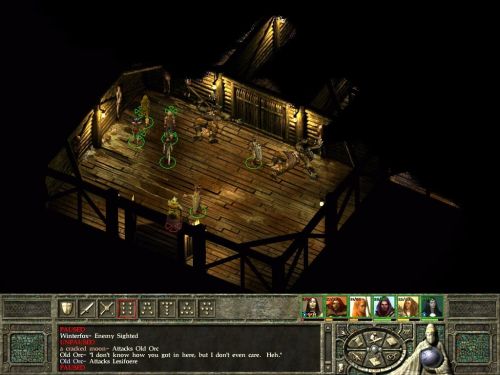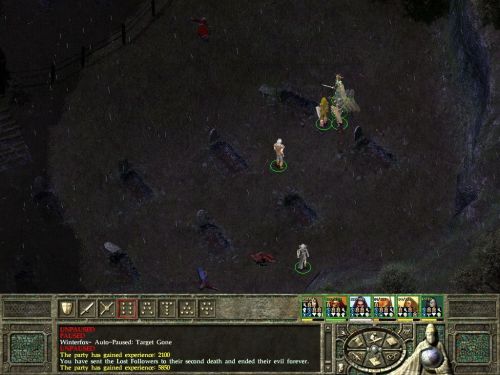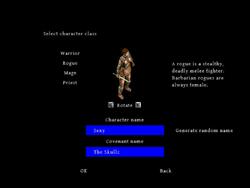RPG Codex Retrospective: Roguey fights for social justice in Josh Sawyer's Icewind Dale II
RPG Codex Retrospective: Roguey fights for social justice in Josh Sawyer's Icewind Dale II
Editorial - posted by Infinitron on Thu 27 June 2013, 13:29:38
Tags: Black Isle Studios; Icewind Dale 2The year was 2002. Under the inept management of the notorious Herve Caen, Interplay was dying. The company needed money fast, and so it was decided to bring back the Infinity Engine for one last hurrah. Icewind Dale II was a project that should never have been. A slam dunk of a slam dunk. A game that nobody had asked for. It would also be Josh Sawyer's first stint as a Lead Designer.
Did Josh do a decent job? Is Icewind Dale II the black sheep of the Infinity Engine games, or is it an underrated classic? Is Josh Sawyer a true progressive, or merely a fauxgressive white boy with a rape fixation? One Codexer has decided to find the answers to those questions.
Strap yourselves in, because it's time for...
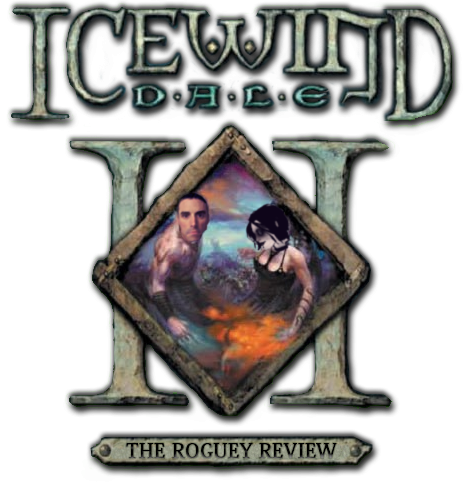
Read the full article: RPG Codex Retrospective Review: Roguey fights for social justice in Josh Sawyer's Icewind Dale II
Did Josh do a decent job? Is Icewind Dale II the black sheep of the Infinity Engine games, or is it an underrated classic? Is Josh Sawyer a true progressive, or merely a fauxgressive white boy with a rape fixation? One Codexer has decided to find the answers to those questions.
Strap yourselves in, because it's time for...

Read the full article: RPG Codex Retrospective Review: Roguey fights for social justice in Josh Sawyer's Icewind Dale II
Ain't got time to make no apology
Life wasn't going smoothly for Black Isle back in 2001. Their parent company Interplay had offset their successes by hemorrhaging money through a series of bad decisions. They needed more money fast, so a sequel to their modestly-successful Dungeons and Dragons dungeon crawl was commissioned and given an absurdly short four-month development cycle. That quickly proved impossible, so they were given a six month extension; ten months to show everyone what they had and hadn't learned from the mistakes of its predecessor.
Heal your disease
Icewind Dale II makes the switch to 3rd edition Dungeons and Dragons rules. Barbarians, monks, and sorcerers have been added as classes, bringing Icewind Dale up to par with Baldur's Gate 2. Moreover, rangers finally get proper dual-wielding. Third edition-style multiclassing (where any race can take almost any class on level-up) replaces the demihuman multiclassing and human dual-classing of 2nd edition; a boon for the fighter and rogue classes who can benefit from self-only buffs and are only worth taking for 4-5 and up to 10-11 levels respectively. Customization is further expanded through the addition of sub-races with their inherent advantages and disadvantages.
The esoteric ability score rules have been replaced with something consistent and easier to understand, though still flawed in that some statistics can be dumped with little-to-no-penalty for certain classes while others are important for everybody. For example, unless one is a bard, cleric, paladin, or sorcerer, there's little reason to have many points in Charisma. Meanwhile, Dexterity affects how often you're hit, how often you can hit with ranged weapons, and your reflex saving throw; definitely not something you can set to the single digits without much consideration.
Non-thief skills are a new addition. The thief skills themselves remain as is, though Stealth has been split into Hide and Move Silently and Find/Remove Traps has been split into Search and Disable Device. Rogues and bards can also invest in Use Magic Device to use wands and scrolls. The Pick Pocket skill continues to be as irritatingly reload-heavy as ever, thanks to unpredictable, unavoidable failures resulting in hostile npcs. Lore has been split into Alchemy (covering potions) and Knowledge (everything else). The ranger's Tracking ability that was introduced in the Icewind Dale expansion has been replaced with Wilderness Lore, and Animal Empathy has been brought in as a mostly-useless option to use instead of the Charm Person or Mammal spell. Spellcasters can now put points into Concentration to avoid spell interruption, which helps both you and your enemies. Additionally, Spellcraft allows you to identify enemy spells as they're being cast to help you plan better tactics. Lastly, Bluff, Diplomacy, and Intimidate make up thedialogue content-skip and better-reward skills. You may have to metagame with your party spokesperson placement since you don't always get to choose when to initiate a conversation.
Feats have also been added, expanding on weapon proficiencies. Every few levels you get to choose a new ability to help you kill enemies better. All the weapon feats are well-supported through stores or loot placed in the world, so you're free to invest in anything without feeling like you made a bad choice. Unfortunately, the poor balance of the other feats results in the illusion of customization. Disregarding weapon and new-player-trap choices, any given class won't look too different from another character from that same class feat-wise, so the biggest decision is in which order to take them. Beware those traps: Great Cleave is worded vaguely enough to look good on paper until you realize it only works if you kill an enemy with your cleave attack, something very unlikely to happen. Since there's no penalty for resting or backtracking to rest as often as you want, having an extra Rage, Wild Shape, Smiting, or Turning is pointless. Improved Initiative is bugged and doesn't work without a fan fix. Monte Cook's favorite trap feat, Toughness*, gives you a pathetic +3 hit points and you can take it five times. Do you want to kill things better or receive a whopping extra 15 HP in a game where you end up with or near low-triple digit HP numbers and can take advantage of other ways to reduce and avoid damage?
The inclusion of the lingering song feat can also very well break the game. If you activate and deactivate a song while paused, the lingering kicks in automatically and each instance stacks. This can lead to slight cheating, like enjoying the benefits of all your songs at once in two-round increments, or extreme cheating by pumping your attack, damage, luck, saving throw, armor class, and damage resistance scores sky high. They fixed the War Chant of the Sith song (an ability that gives you +2 AC and damage reduction and heals 3 hit points per round) by having it only take effect during combat, but it's all for naught if you can just mash a hotkey and degenerately heal your characters in 3 HP increments while paused.
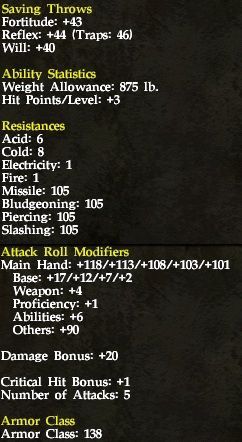
I have no rival; no man can be my equal.
You have access to over 300 spells now, and unlike Icewind Dale, you're encouraged to use them. Good and neutral Clerics can spontaneously cast cure spells by shift-clicking on a spell of any given level, adding some much-appreciated flexibility. Enemies have different elemental and saving throw resistances in an attempt to prevent any one spell from dominating. In spite of this, being able to automatically hit helpless enemies (a concession to 3rd edition's coup de grace) results in spells such as Hold Person/Monster and fifth-level+ Chromatic Orb becoming more powerful than ever.
Overall, this significant increase in customization means creating an effective, interesting party requires a lot of comprehension and upfront planning before you even start playing. Your mileage may vary regarding whether this is good or bad, but new players definitely have a large hurdle to get past. This is a game made and tuned for D&D veterans.*
Your pretty face is going to hell
The initial four month schedule presumably resulted in the quality of background art taking a step for the worse. It does eventually improve, particularly in the areas reused from the first. The user interface now has an aesthetically unpleasant color scheme, but has improved functionality; portraits are closer to the action bar, the action bar itself is fully customizable, the inventory has another row for items (though I still recommend using a mod to remove stack and container limits), and the move to 800x600 means more information can be presented at once. The new spell icons are also easier to read, though their radiance clashes with the art style.
I found the soundtrack in the previous title forgettable; this time around it's annoying bombast. I eventually had to turn down the volume when loading a save so I wouldn't have to hear that awful musical sting. Sound effects remain satisfying, while voice acting continues to be well-done with a few weak areas (Madae's first few lines in particular). The beginning and ending cinematics are adequate enough, but the one between the first and second chapter is superfluous, considering the chapter 2 introduction repeats it nearly verbatim. Josh Sawyer, who wrote all the narration*, messed up there.
I am dying in a story
The writing in IWD2 is more interesting than its predecessor thanks to Josh Sawyer's creative vision. The primary antagonists are kept humanized and their motivations are more complex than wanting to harvest souls for their demon vs. devil Blood War. You're also saving the Ten Towns, as opposed to the world, from a problem they brought on themselves through the indifference and discourtesy of their leaders. There's more humor too, which prevents the narrative from spiraling into never-ending bleakness. The Medallion of the Lost* and the Holy Avenger* are the unique equipment highlights; Damien Foletto or Chris Avellone*did a great job there. The sequel also preserves the class, race, sex, and ability score dialogue checks, as well as the foreshadowing from the previous installment.
It's still not a great story by any means. The quick turnaround meant the outline had to be written in 24 hours* and couldn't be revised as extensively as they would have liked. The most glaring problem I found is how you're not given an acceptable reason for why you can’t side with or take over the Legion of the Chimera. The only positive response you're able to give regarding their goal of unifying all the "dispossessed freaks and half-breeds" is to call it "noble enough in its own twisted, nonsensical way" even though there's nothing nonsensical about it. It is twisted, but so is the history of most current nations.
There's also a massive amount of rape; more than nearly any other mainstream game of which I am aware. It even retcons* a lot of rape into the original Icewind Dale. These aren't just your run-of-the-mill legitimate rapes either, but systematic monster rapes that result in pregnancy; that old xenophobic subtext revealing white men's fear of The Non-White Other invading their homes and taking "their" women.

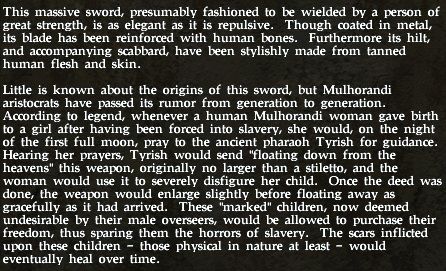

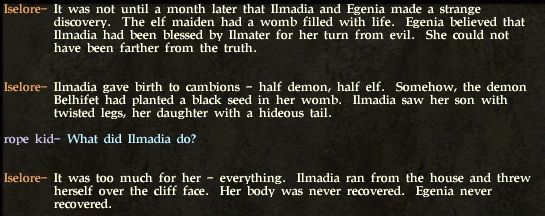
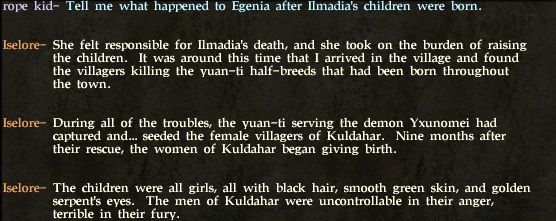


Also female-on-male rape is pleasurable and hilarious, so decrees the patriarchy.
On further reflection I realized Josh Sawyer's fixation with rape isn't just limited to IWD2, but rather every project with his writing contributions. He's the one who brought Ginnafae and Marketh into IWD; the only rape situation in that game as far as I can remember. The Black Hound would have included a character who had become pregnant from rape.* The Alien series is all about impregnating rape* and the Aliens RPG would have been no exception. Sawyer ordered George Ziets to write a quest about rape into Fallout: New Vegas*; additionally, he introduced Caesar's Legion, an army that rapes their way across the wasteland. I don't understand why someone who believes that "writing about topics with which you are familiar is a good approach"* is so fixated with a subject he himself can never experience (with the lone exception of that oh-so-pleasurable and funny yuan-ti female-on-male rape). It's not as if one can't write a mature RPG without rape; (as far as I can remember) Planescape: Torment and Mask of the Betrayer did just fine. I'll have to resign myself to the fact that Sawyer is the Alan Moore* of western role playing video games. There are worse things one can be.
See me through on my death trip
When it comes to gameplay, the days of lazily selecting all your characters and attacking a single opponent are largely over, at least until you get to the mid-game. Even then there's much less routine combat per chapter than there was in the original (with the exception of chapter 5) and there are interesting encounters in every area to hold your interest. Many battles are still demanding even with a fully-rested party. The higher difficulty modes change certain battles without giving you extra experience per kill and you can still remove the extra damage component in the ini. I'm impressed with how much they've improved.
I played on normal difficulty for consistency's sake. Just like my previous review there'll be massive spoilers from here on out as I describe my subjective experience through each area.
Chris Avellone starts us off in Targos, and he's in a New Reno state of mind. There are pop culture references (Star Trek and The Lion, The Witch, and the Wardrobe), another Ravel appearance, a lot of dialogue poking fun at the formulaic nature of tutorial areas, and colorful commentary from the game master.
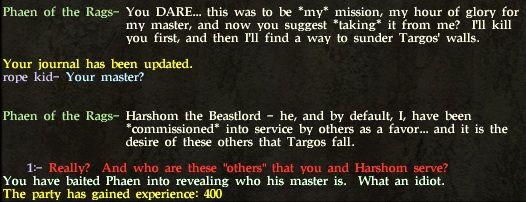

Avellone is drunk again.
The area's levels are annoyingly narrow with too many chokepoints; unfortunately this is the norm. I don't understand why they would create levels like this knowing the severe limitations of the Infinity Engine's pathfinding algorithms. Nevertheless, the dead bodies from a previous battle in the first map are a nice touch, as is the NPC who allows you to fast travel among the three maps.
As for combat, this is a tutorial, so there's nothing but select-all and attack for now. You'd have to be pretty bad at making D&D characters to have difficulty with any of it, including the lengthy palisade battle at the end. Difficult low-level D&D combat wouldn't even be a good idea considering how fragile your characters are; nonetheless, Avellone expressed perhaps a bit too much undeserved pride over the way he handled the combat in the area* considering how uninvolving it is.
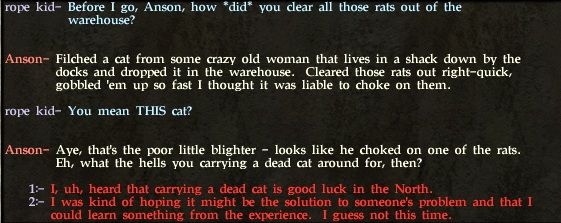
He took that brick, and he just chucked it way up in the air.
The intensity sharply increases in chapter 1. Nearly every battle is an ordeal; John Deiley did a fantastic job of learning from his Icewind Dale, Heart of Winter, and Trials of the Luremaster mistakes.* In fact he may have gone a bit too far the other way; the difficulty is high enough that I had to take a break at least every other battle to relax and clear my head. Trying to do too much would make it feel like a slog. Listing every battle would be too much so I'll cover it in broad strokes. There are plenty of orc archers and animal summoning shamans. Interesting new additions include firestarters and runners; runners will place a potentially explosive barrel near your party and a firestarter will ignite it, giving you a few seconds to retreat before it explodes. Of course you can use this to your advantage by getting them to blow themselves up, though you lose out on the XP by doing this. The second map gives you the optional challenge of rescuing villagers from getting blown up; if you fail (whether accidentally and rolling with it or on purpose because of your party concept), they'll appear in a later map as undead enemies. This map also has an optional quest where you have to get a sword back from a troll. This massive damage-dealing troll has a shaman friend who likes to start the battle by casting Sleep and Command on your party to disable them. There are also archers to deal with and two flanking guards; you can take care of the guards beforehand, but doing so aggros everybody and you miss out on the dialogue xp you'd get from the conversation (a good incentive to get you to play things the "right" way).
The subsequent map mixes things up by adding wererats and werebadgers. They require magic weapons to be hit since there are no silver materials in this game. The set piece of this area is a cramped battle with wererats, werebadgers, orc archers, two animal-summoning shamans, poisoning spiders, and their spider queen; difficulty through facing an overwhelming diverse force in close quarters. The one after goes for something different by having you face Malarite priests along with their pets; it's difficult to prioritize because they all do a lot of damage. Lastly, there's a climactic fight where you have to deal with all the enemy types you've faced so far in a race against time to save a bridge from being destroyed by ogres. You can succeed, partially succeed, or fail at this task with varying XP rewards as a consequence. The debilitating Color Spray-casting mage boss drops a bag of holding; the greatest reward you've received yet.
You'd think that'd be it for chapter one, but then they send you to the horde fortress to wipe out the rest of the orc and goblin force. Producer Chris Parker takes over* with some minor finishes from Damien Foletto*. New tricks include a bit more openness in the first map, trapped bridges, archers on elevated ground, and worg-summoning drums commandeered by shamans. Either destroy the drum or the shaman before it reaches it to avoid the hassle. Another battle has all this and two hardened ice trolls (troll/construct hybrids that are vulnerable to fire and magical blunt weapons and resistant to just about everything else). The first fight in the goblin warrens has you facing over 20 goblins and the reward is the fireball and skull trap spells (which would have been good to have before the fight; a nice tease). Immediately following this you have to deal with a Hold Person and Charm Person-casting shaman and a Magic Missile-casting witch doctor along with a mob that will take advantage of your held state (remember what I mentioned earlier about helpless enemies getting autohit? That applies to your party as well). Next you have to deal with a similar group, except this one has a sorcerer who starts the battle by casting web on your party. You can make this battle easier by sending a stealthy or invisible character past them to open a door; three spiders will come out immediately and attack the goblins. After they inevitably lose, all the enemies will be clustered in a group and susceptible to getting tangled in a web and pelted with area of effect spells or items themselves.
They turn down the heat at this point with a few trash mobs and a couple of dialogue-oriented quests to remind you that the humanoids you've been killing by the dozens aren't just generically evil would-be conquerors.
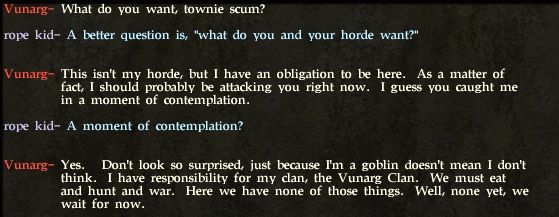
A diplomatic character can get this guy to leave peacefully.
Once you're at the horde entrance you have a big fight with a lot of elevated archers, a Mirror Image-protected mage, a few giants, and another hardened ice troll. Inside, a potion-drinking, tough Old Orc pops up behind you as soon as you've killed the two bugbear guards.
Afterwards, you get flanked in a narrow hallway by a chieftain and his bodyguards at the bottom and a shaman and his bodyguards at the top; a test of priorities. An optional encounter at the top of the map involves a room with two sorcerers, a witch doctor, and a shaman spread out so they can't all be hit with a single area of effect spell. Finally, there's the melee boss of the area with his two casters and two high strength melee chieftains.
Chapter 2 starts with significantly reduced difficulty and an outdoor area littered with traps. It's not entirely humdrum: you're introduced to boulder-throwing giants, an optional battle with lycanthropes is different depending on the time of day (of course), and you can avoid slaughtering a village of people stuck between a rock and a hard place through the use of Intimidate and Pick Pocket. The second map reintroduces remorhazes, now with extra burning damage. The remorhaz queen is supported by two clerics and frequently casts Sol's Searing Orb, a spell that can cause blindness and do a lot of damage unless a fortitude save is made. Her death creates a massive explosion that damages anyone in its radius and opens up the wall behind her, immediately starting another fight with an opponent who begins his attack with a Fireball spell. After taking care of two necromancers and a crystal golem (lest they join the next fight) you have another boss to deal with in the form of a half-dragon, a Chain Lightning-casting shaman, three clerics, and a couple of melee opponents. When the half-dragon takes enough damage she moves up the stairs, turns them into a sliding ramp, and starts throwing Oils of Fiery Burning at you, forcing you to finish the rest of the fight with ranged weapons and spells.
The Ice Temple is mostly filled with trash. It's also home to Battle Squares, a tedious series of 250 (!!!) one vs. one fights with awesome prizes to be had every 25 fights. I recommend skipping it or cheating your way through if you can't resist the siren call of prizes. The area isn't entirely boring though; there are a couple of fights against Hold Person-casting clerics with an ice golem champion and an optional party vs. party match involving a fighter, rogue, wizard, and cleric with nine generic henchmen. The climactic battle takes a turn for the slightly interesting when the boss "dies" and "resurrects" on the ethereal plane, requiring you to send one of your party members to another room to flip a switch while the rest of your party takes damage from an invincible opponent.
Chapter 3 kicks off with an easy fight followed by a harder one where you're flanked by wolves. After relaxing a bit at a small village, you're sent on a series of errands; you can completely avoid a lot of tedious trash fights and backtracking if you have a paladin and a bard in your party. I'm grateful for the content-skip options considering how unenjoyable this particular content is.
While on the first errand you'll run into a group of trolls and a troll shaman who casts Protection from Fire. Why didn't those jerks think to do something like this sooner? Of course they can still be killed with acid or hit with a Dispel Magic spell if you absolutely must use fire. Next up is a teleporting mage surrounded by a bunch of snow trolls; if you don't immediately disable her spell-casting abilities or freeze her in place, she'll teleport again and the next time you see her she'll be surrounded by a horde of summoned monsters and start doing everything she can to Charm your party members.

Patriarchy is never too young to smash.
Eventually you're forced to enter the Fell Wood maze. I hope you put points into the Wilderness Lore skill; otherwise you're in for a trial-and-error, save-and-reload-heavy bad time (unless you just look up the solution). There's no interesting combat in the maze, unsurprisingly. Once you're through, you get to face more trolls and Protection from Fire-casting troll shamans who have also added Hold Person to their repertoire. After wiping out a platoon of barbarians and a couple of tough-but-not-too-interesting white dragons and their wyrmlings, you're in Hook Horror country. The first flanking ambush is fun, but then they keep repeating it over and over. You can optionally aggro a large group of slave-owning duergar; a pity the very slaves you're trying to free end up defending their masters with their lives. At least you get an awesome magic crossbow that attacks 3 times per round out of the ordeal.
The final fight of the chapter is a beastlord with four war bears, four archers, and two Stoneskin and Mirror Image-protected wizards. The mages are fond of Gedlee's Electric Loop, a spell that does electric damage and can stun you for one round if you fail your reflex save. I particularly enjoyed how you can choose not to take them seriously.
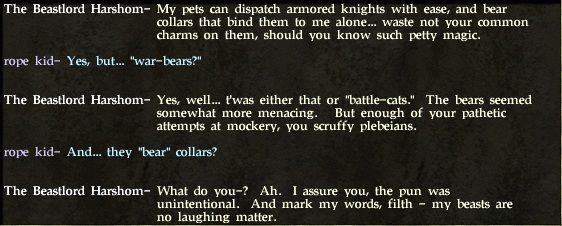
I can hardly bear it.
After a few quick trash fights, chapter 4 brings you to a monastery full of dull single character puzzles with combat. The worst is the last, where you have to kill two bronze monks while Flame Strikes go off everywhere. With this nonsense out of the way, you get the chance to rob the monks blind and fight four iron golems at once. These things deal a lot of damage, have a poisonous aoe ability, are immune to spells (but are slowed by lightning), and require +3 weapons to hit. Once past the golems, we're in the Underdark and greeting a very-much-alive-and-reasonable Malavon. It's revealed that the mad bastard from the previous game was a degenerate clone in a retcon straight out of bad superhero comics. Ginnafae's back too, in Drider form. You can tell her it's safe to go back to Malavon's camp where he'll cure her and teleport them to a presumably-happy ending.

Yes, that's Marketh's statue from Lower Dorn's Deep. Malavon's going to need to make a return trip.
Some of the drider fights can be interesting thanks to their use of Web, Hold Person, and Charm. The most interesting is when you have to fight the red wizard who created them, a few flesh golems, and three unique driders; one in particular is an annoying spellcaster who unleashes a ton of smaller spawn on death. With the drider infestation wiped out, it's time to take on mind flayers; unfortunately, they're not the intelligence-devouring beasts from Baldur's Gate 2. There's a decent fight with a mind flayer, four of those boulder-throwing giants, two mages, and fighter reinforcements who come in mid-battle, but that's pretty much it. The Elder Brain isn't anything special if you wipe out all its thralls before attacking; you can intimidate it into leaving you alone but then you miss out on XP. The final battle of the chapter, with its harpies, earth elementals, and two spellcasters, is also a bit of a let-down.
The opening area of chapter 5 puts Avellone back in the game master's chair*; easy fights and lengthier dialogues await. After a surprisingly long absence, the undead are back in groups; I do appreciate how IWD2 doesn't include large amounts of undead in practically every chapter like its predecessor, but it's nice to be able to get some use out of Turn Undead and other anti-undead specific spells every once in a while. The orphaned kid from IWD is also back and a racist; probably has something to do with orcs killing his family.
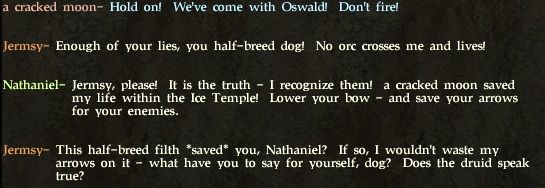
Better a mutt than a sickly inbred purebred.
The undead thankfully don't overstay their welcome and the event ends in a cramped cave with a constantly-healing cleric, four wraiths, and a bunch of neo-orogs. Then it's on to Kuldahar proper where you have to deal with a lot of yuan-ti trash, meet some more old friends, and read through a ton of exposition.
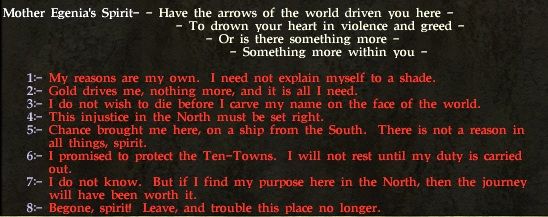
What is the nature of an adventurer?
One map full of yuan-ti wasn't enough for the IWD2 team so you have to enter a portal into Chult to kill even more. Fortunately, you can take the robes from the dead bodies of a few initiates and bluff your way through the yuan-ti temple without having to kill anyone inside. A paladin will refuse to partake in such underhanded tactics, so I recommend killing the character outside the temple, exploring and talking until you've had your fill, then going outside to resurrect the character so you can go back inside and slaughter everyone for the XP. There's an enjoyable room full of assassins and sorcerers to kill; if you don't take them out there, they'll show up to ambush you once you kill the head priest and his disciples. If you choose not to wipe out the temple, or if you want even more XP, you can summon the portal guardian outside; it has over 450 hit points, 30 AC, high spell resistance, requires +4 weapons to be hit, has an acidic area of effect attack, does large amounts of melee damage, and causes fear. On the plus side it's vulnerable to electric damage and killing it gives you a permanent boost to acid resistance and HP. If you choose to kill the dragon, you'll have to face an easy six waves of enemies back in Kuldahar before you're able to rest; they're also courteous enough to fill up your HP again so you don't find yourself in an unwinnable situation.
We're still not done with lizard-people; now it's on to Dragon's Eye, and it's a disappointing trash mob-filled area compared to what it was in Icewind Dale. Its semi-interesting ideas include enemies with fear-inducing crossbow bolts, yuan-ti halfblood casters who teleport in mid-battle (an aspect Bioware would come to love and eventually copy ad nauseam), and a mustard jelly and olive slime ambush that requires fire to handle. After three floors of boredom you finally get something fun when you have to kill a large group of efreet with red fire shields that make them cold-resistant and deal fire damage to anyone who attacks them in melee (unless they have a lot of fire resistance themselves). This is immediately followed by a battle with a cleric who constantly heals and summons dozens of snakes. Your reward for completing this is the Vipergout spell, which lets your mage vomit snakes him/herself, and the opportunity to go back to Kuldahar and take care of a nasty high-level undead adventuring party for an awesome paladin-only sword. They can do a lot of damage in a short amount of time, particularly since the mage begins the fight by casting Executioner's Eyes, a spell that gives them a +4 bonus to their attack and critical hit rolls.
The fourth level of Dragon's Eye goes for something completely different and puts you in a time loop with an intriguing story. The constant lava mephit trash just serves as an annoying distraction and it'd be more enjoyable if they didn't exist. There's a challenging fight with a beholder, trolls, flamewalkers, efreet, hell hounds, and lava mephits on the first day, but after that it's just a dialogue-heavy ride.
If you received help from a NPC back in chapter 2 you're then teleported back to the Ice Temple to wipe out demon trash. It's practically-free XP. The final area of the chapter-that-just-won't-end (that also has more combat than any other chapter, even 1.5x as much as chapter 1 where it was mostly fun) starts off with something challenging in the form of a red wizard who begins the fight by casting Blasphemy (a spell with no save that stuns every creature of non-evil alignment for one round; your cleric can have access to its good equivalent, so there's a level playing field). Moving too far up will aggro some bladesingers, making the fight even more difficult. Once they're taken care of, we're back to more undead; at least you can bluff your way past the first group. The second group contains a lich who goes invisible and can cast Power Word Kill. If you're quick enough you can even pick up some holy water and dump it in a waterfall to kill all the undead at once, though you end up losing the XP from killing them individually. The chapter-ending fight is another red wizard battle, though there's no Blasphemy this time.
Chapter 6 has the least amount of combat in the game; thank you so much, John Deiley and Damien Foletto. You can bluff your way past the guard at the Severed Hand entrance and then pick up a delegate pass on the first floor to keep those pesky indoor guards from attacking you on sight. What follows is a lot of entertaining exploring, talking, and acceptable "content-skipping."
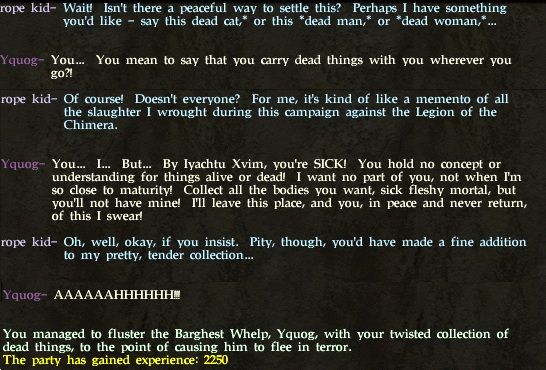
Do you know what the dog had in its mouth?
The combat you can engage in is pretty fun for the most part, keeping up Deiley's winning streak. The third floor has a section where the two chokepoints leading to the enemies are trapped and you have to face a cleric who casts Symbol of Hopelessness (a spell that freezes your characters for 10 rounds unless you make a will save) and a couple of slayer knights with +5 vampiric great swords. An optional fight at the top of the cleric tower has you facing a group of clerics and the ghosts of some of the bosses from previous chapters (who are now vulnerable to Turn Undead). Completing it gets you some extra aid in the final battle.
Unless you want to kill 10 innocent slaves, you'll end up having to take on a bunch of demons and a lesser deity who has 500 HP, fire immunity, and damage resistance to anything that isn't a +3-or-higher crushing weapon. The penultimate fight involves three blindness-casting half-dragons, two wizards, a cleric, another slayer knight, and a half-orc in a small area. The final battle has you facing a pre-buffed Isair and Madae (a sorcerer and a cleric, respectively) and a chaotic mess of summoned creatures (until you kill the summoner). Madae will cast Blasphemy at the start of both phases of the battle, so pre-buffing is a must if your party is mostly non-evil. They make for a more interesting final boss fight than Belhifet or Icasaracht, though they're not too difficult if you've mastered the system. Interestingly enough, Isair and Madae end up causing their own downfall; the fate of the Legion would remain unchanged even if your characters had never arrived in Targos (whether they're tragic heroes or villains hoisted with their own petard is up to the individual to decide). A cynical person might believe this means your actions ultimately had no meaning; however, this would require ignoring all the NPCs you helped on the journey.
Memory, you gotta go
Icewind Dale II manages to be a decent linear dungeon crawl in spite of its rushed development cycle and janky rules. Every chapter has its flaws, but they're usually a result of trying to deliver too much content or trying to do too much with that aging Infinity Engine technology in the time they were given. I liked it much better than the first; if anything this should be the one making top ten lists (near the bottom of course). Josh Sawyer and his team did a great job when it came to preventing this from becoming an embarrassment, and I'm positive he could lead a team into making something unquestionably good if given enough time.
"Icewind Dale II started development the same day that TORN was cancelled and five people were laid off. It was the first time that people had been laid off in Black Isle, so it wasn't exactly a happy beginning. A lot of other people left shortly after development started because IWD2 looked like it would be an embarassment...One of those people was the lead designer, so I did double duty on IWD2 while FR6/The Black Hound sort of simmered in the background."--Josh Sawyer*
Life wasn't going smoothly for Black Isle back in 2001. Their parent company Interplay had offset their successes by hemorrhaging money through a series of bad decisions. They needed more money fast, so a sequel to their modestly-successful Dungeons and Dragons dungeon crawl was commissioned and given an absurdly short four-month development cycle. That quickly proved impossible, so they were given a six month extension; ten months to show everyone what they had and hadn't learned from the mistakes of its predecessor.
Heal your disease
Icewind Dale II makes the switch to 3rd edition Dungeons and Dragons rules. Barbarians, monks, and sorcerers have been added as classes, bringing Icewind Dale up to par with Baldur's Gate 2. Moreover, rangers finally get proper dual-wielding. Third edition-style multiclassing (where any race can take almost any class on level-up) replaces the demihuman multiclassing and human dual-classing of 2nd edition; a boon for the fighter and rogue classes who can benefit from self-only buffs and are only worth taking for 4-5 and up to 10-11 levels respectively. Customization is further expanded through the addition of sub-races with their inherent advantages and disadvantages.
The esoteric ability score rules have been replaced with something consistent and easier to understand, though still flawed in that some statistics can be dumped with little-to-no-penalty for certain classes while others are important for everybody. For example, unless one is a bard, cleric, paladin, or sorcerer, there's little reason to have many points in Charisma. Meanwhile, Dexterity affects how often you're hit, how often you can hit with ranged weapons, and your reflex saving throw; definitely not something you can set to the single digits without much consideration.
Non-thief skills are a new addition. The thief skills themselves remain as is, though Stealth has been split into Hide and Move Silently and Find/Remove Traps has been split into Search and Disable Device. Rogues and bards can also invest in Use Magic Device to use wands and scrolls. The Pick Pocket skill continues to be as irritatingly reload-heavy as ever, thanks to unpredictable, unavoidable failures resulting in hostile npcs. Lore has been split into Alchemy (covering potions) and Knowledge (everything else). The ranger's Tracking ability that was introduced in the Icewind Dale expansion has been replaced with Wilderness Lore, and Animal Empathy has been brought in as a mostly-useless option to use instead of the Charm Person or Mammal spell. Spellcasters can now put points into Concentration to avoid spell interruption, which helps both you and your enemies. Additionally, Spellcraft allows you to identify enemy spells as they're being cast to help you plan better tactics. Lastly, Bluff, Diplomacy, and Intimidate make up the
Feats have also been added, expanding on weapon proficiencies. Every few levels you get to choose a new ability to help you kill enemies better. All the weapon feats are well-supported through stores or loot placed in the world, so you're free to invest in anything without feeling like you made a bad choice. Unfortunately, the poor balance of the other feats results in the illusion of customization. Disregarding weapon and new-player-trap choices, any given class won't look too different from another character from that same class feat-wise, so the biggest decision is in which order to take them. Beware those traps: Great Cleave is worded vaguely enough to look good on paper until you realize it only works if you kill an enemy with your cleave attack, something very unlikely to happen. Since there's no penalty for resting or backtracking to rest as often as you want, having an extra Rage, Wild Shape, Smiting, or Turning is pointless. Improved Initiative is bugged and doesn't work without a fan fix. Monte Cook's favorite trap feat, Toughness*, gives you a pathetic +3 hit points and you can take it five times. Do you want to kill things better or receive a whopping extra 15 HP in a game where you end up with or near low-triple digit HP numbers and can take advantage of other ways to reduce and avoid damage?
The inclusion of the lingering song feat can also very well break the game. If you activate and deactivate a song while paused, the lingering kicks in automatically and each instance stacks. This can lead to slight cheating, like enjoying the benefits of all your songs at once in two-round increments, or extreme cheating by pumping your attack, damage, luck, saving throw, armor class, and damage resistance scores sky high. They fixed the War Chant of the Sith song (an ability that gives you +2 AC and damage reduction and heals 3 hit points per round) by having it only take effect during combat, but it's all for naught if you can just mash a hotkey and degenerately heal your characters in 3 HP increments while paused.

I have no rival; no man can be my equal.
You have access to over 300 spells now, and unlike Icewind Dale, you're encouraged to use them. Good and neutral Clerics can spontaneously cast cure spells by shift-clicking on a spell of any given level, adding some much-appreciated flexibility. Enemies have different elemental and saving throw resistances in an attempt to prevent any one spell from dominating. In spite of this, being able to automatically hit helpless enemies (a concession to 3rd edition's coup de grace) results in spells such as Hold Person/Monster and fifth-level+ Chromatic Orb becoming more powerful than ever.
Overall, this significant increase in customization means creating an effective, interesting party requires a lot of comprehension and upfront planning before you even start playing. Your mileage may vary regarding whether this is good or bad, but new players definitely have a large hurdle to get past. This is a game made and tuned for D&D veterans.*
Your pretty face is going to hell
The initial four month schedule presumably resulted in the quality of background art taking a step for the worse. It does eventually improve, particularly in the areas reused from the first. The user interface now has an aesthetically unpleasant color scheme, but has improved functionality; portraits are closer to the action bar, the action bar itself is fully customizable, the inventory has another row for items (though I still recommend using a mod to remove stack and container limits), and the move to 800x600 means more information can be presented at once. The new spell icons are also easier to read, though their radiance clashes with the art style.
I found the soundtrack in the previous title forgettable; this time around it's annoying bombast. I eventually had to turn down the volume when loading a save so I wouldn't have to hear that awful musical sting. Sound effects remain satisfying, while voice acting continues to be well-done with a few weak areas (Madae's first few lines in particular). The beginning and ending cinematics are adequate enough, but the one between the first and second chapter is superfluous, considering the chapter 2 introduction repeats it nearly verbatim. Josh Sawyer, who wrote all the narration*, messed up there.
I am dying in a story
The writing in IWD2 is more interesting than its predecessor thanks to Josh Sawyer's creative vision. The primary antagonists are kept humanized and their motivations are more complex than wanting to harvest souls for their demon vs. devil Blood War. You're also saving the Ten Towns, as opposed to the world, from a problem they brought on themselves through the indifference and discourtesy of their leaders. There's more humor too, which prevents the narrative from spiraling into never-ending bleakness. The Medallion of the Lost* and the Holy Avenger* are the unique equipment highlights; Damien Foletto or Chris Avellone*did a great job there. The sequel also preserves the class, race, sex, and ability score dialogue checks, as well as the foreshadowing from the previous installment.
It's still not a great story by any means. The quick turnaround meant the outline had to be written in 24 hours* and couldn't be revised as extensively as they would have liked. The most glaring problem I found is how you're not given an acceptable reason for why you can’t side with or take over the Legion of the Chimera. The only positive response you're able to give regarding their goal of unifying all the "dispossessed freaks and half-breeds" is to call it "noble enough in its own twisted, nonsensical way" even though there's nothing nonsensical about it. It is twisted, but so is the history of most current nations.
There's also a massive amount of rape; more than nearly any other mainstream game of which I am aware. It even retcons* a lot of rape into the original Icewind Dale. These aren't just your run-of-the-mill legitimate rapes either, but systematic monster rapes that result in pregnancy; that old xenophobic subtext revealing white men's fear of The Non-White Other invading their homes and taking "their" women.







Also female-on-male rape is pleasurable and hilarious, so decrees the patriarchy.
On further reflection I realized Josh Sawyer's fixation with rape isn't just limited to IWD2, but rather every project with his writing contributions. He's the one who brought Ginnafae and Marketh into IWD; the only rape situation in that game as far as I can remember. The Black Hound would have included a character who had become pregnant from rape.* The Alien series is all about impregnating rape* and the Aliens RPG would have been no exception. Sawyer ordered George Ziets to write a quest about rape into Fallout: New Vegas*; additionally, he introduced Caesar's Legion, an army that rapes their way across the wasteland. I don't understand why someone who believes that "writing about topics with which you are familiar is a good approach"* is so fixated with a subject he himself can never experience (with the lone exception of that oh-so-pleasurable and funny yuan-ti female-on-male rape). It's not as if one can't write a mature RPG without rape; (as far as I can remember) Planescape: Torment and Mask of the Betrayer did just fine. I'll have to resign myself to the fact that Sawyer is the Alan Moore* of western role playing video games. There are worse things one can be.
See me through on my death trip
When it comes to gameplay, the days of lazily selecting all your characters and attacking a single opponent are largely over, at least until you get to the mid-game. Even then there's much less routine combat per chapter than there was in the original (with the exception of chapter 5) and there are interesting encounters in every area to hold your interest. Many battles are still demanding even with a fully-rested party. The higher difficulty modes change certain battles without giving you extra experience per kill and you can still remove the extra damage component in the ini. I'm impressed with how much they've improved.
I played on normal difficulty for consistency's sake. Just like my previous review there'll be massive spoilers from here on out as I describe my subjective experience through each area.
Chris Avellone starts us off in Targos, and he's in a New Reno state of mind. There are pop culture references (Star Trek and The Lion, The Witch, and the Wardrobe), another Ravel appearance, a lot of dialogue poking fun at the formulaic nature of tutorial areas, and colorful commentary from the game master.


Avellone is drunk again.
The area's levels are annoyingly narrow with too many chokepoints; unfortunately this is the norm. I don't understand why they would create levels like this knowing the severe limitations of the Infinity Engine's pathfinding algorithms. Nevertheless, the dead bodies from a previous battle in the first map are a nice touch, as is the NPC who allows you to fast travel among the three maps.
As for combat, this is a tutorial, so there's nothing but select-all and attack for now. You'd have to be pretty bad at making D&D characters to have difficulty with any of it, including the lengthy palisade battle at the end. Difficult low-level D&D combat wouldn't even be a good idea considering how fragile your characters are; nonetheless, Avellone expressed perhaps a bit too much undeserved pride over the way he handled the combat in the area* considering how uninvolving it is.

He took that brick, and he just chucked it way up in the air.
The intensity sharply increases in chapter 1. Nearly every battle is an ordeal; John Deiley did a fantastic job of learning from his Icewind Dale, Heart of Winter, and Trials of the Luremaster mistakes.* In fact he may have gone a bit too far the other way; the difficulty is high enough that I had to take a break at least every other battle to relax and clear my head. Trying to do too much would make it feel like a slog. Listing every battle would be too much so I'll cover it in broad strokes. There are plenty of orc archers and animal summoning shamans. Interesting new additions include firestarters and runners; runners will place a potentially explosive barrel near your party and a firestarter will ignite it, giving you a few seconds to retreat before it explodes. Of course you can use this to your advantage by getting them to blow themselves up, though you lose out on the XP by doing this. The second map gives you the optional challenge of rescuing villagers from getting blown up; if you fail (whether accidentally and rolling with it or on purpose because of your party concept), they'll appear in a later map as undead enemies. This map also has an optional quest where you have to get a sword back from a troll. This massive damage-dealing troll has a shaman friend who likes to start the battle by casting Sleep and Command on your party to disable them. There are also archers to deal with and two flanking guards; you can take care of the guards beforehand, but doing so aggros everybody and you miss out on the dialogue xp you'd get from the conversation (a good incentive to get you to play things the "right" way).
The subsequent map mixes things up by adding wererats and werebadgers. They require magic weapons to be hit since there are no silver materials in this game. The set piece of this area is a cramped battle with wererats, werebadgers, orc archers, two animal-summoning shamans, poisoning spiders, and their spider queen; difficulty through facing an overwhelming diverse force in close quarters. The one after goes for something different by having you face Malarite priests along with their pets; it's difficult to prioritize because they all do a lot of damage. Lastly, there's a climactic fight where you have to deal with all the enemy types you've faced so far in a race against time to save a bridge from being destroyed by ogres. You can succeed, partially succeed, or fail at this task with varying XP rewards as a consequence. The debilitating Color Spray-casting mage boss drops a bag of holding; the greatest reward you've received yet.
You'd think that'd be it for chapter one, but then they send you to the horde fortress to wipe out the rest of the orc and goblin force. Producer Chris Parker takes over* with some minor finishes from Damien Foletto*. New tricks include a bit more openness in the first map, trapped bridges, archers on elevated ground, and worg-summoning drums commandeered by shamans. Either destroy the drum or the shaman before it reaches it to avoid the hassle. Another battle has all this and two hardened ice trolls (troll/construct hybrids that are vulnerable to fire and magical blunt weapons and resistant to just about everything else). The first fight in the goblin warrens has you facing over 20 goblins and the reward is the fireball and skull trap spells (which would have been good to have before the fight; a nice tease). Immediately following this you have to deal with a Hold Person and Charm Person-casting shaman and a Magic Missile-casting witch doctor along with a mob that will take advantage of your held state (remember what I mentioned earlier about helpless enemies getting autohit? That applies to your party as well). Next you have to deal with a similar group, except this one has a sorcerer who starts the battle by casting web on your party. You can make this battle easier by sending a stealthy or invisible character past them to open a door; three spiders will come out immediately and attack the goblins. After they inevitably lose, all the enemies will be clustered in a group and susceptible to getting tangled in a web and pelted with area of effect spells or items themselves.
They turn down the heat at this point with a few trash mobs and a couple of dialogue-oriented quests to remind you that the humanoids you've been killing by the dozens aren't just generically evil would-be conquerors.

A diplomatic character can get this guy to leave peacefully.
Once you're at the horde entrance you have a big fight with a lot of elevated archers, a Mirror Image-protected mage, a few giants, and another hardened ice troll. Inside, a potion-drinking, tough Old Orc pops up behind you as soon as you've killed the two bugbear guards.
Afterwards, you get flanked in a narrow hallway by a chieftain and his bodyguards at the bottom and a shaman and his bodyguards at the top; a test of priorities. An optional encounter at the top of the map involves a room with two sorcerers, a witch doctor, and a shaman spread out so they can't all be hit with a single area of effect spell. Finally, there's the melee boss of the area with his two casters and two high strength melee chieftains.
Chapter 2 starts with significantly reduced difficulty and an outdoor area littered with traps. It's not entirely humdrum: you're introduced to boulder-throwing giants, an optional battle with lycanthropes is different depending on the time of day (of course), and you can avoid slaughtering a village of people stuck between a rock and a hard place through the use of Intimidate and Pick Pocket. The second map reintroduces remorhazes, now with extra burning damage. The remorhaz queen is supported by two clerics and frequently casts Sol's Searing Orb, a spell that can cause blindness and do a lot of damage unless a fortitude save is made. Her death creates a massive explosion that damages anyone in its radius and opens up the wall behind her, immediately starting another fight with an opponent who begins his attack with a Fireball spell. After taking care of two necromancers and a crystal golem (lest they join the next fight) you have another boss to deal with in the form of a half-dragon, a Chain Lightning-casting shaman, three clerics, and a couple of melee opponents. When the half-dragon takes enough damage she moves up the stairs, turns them into a sliding ramp, and starts throwing Oils of Fiery Burning at you, forcing you to finish the rest of the fight with ranged weapons and spells.
The Ice Temple is mostly filled with trash. It's also home to Battle Squares, a tedious series of 250 (!!!) one vs. one fights with awesome prizes to be had every 25 fights. I recommend skipping it or cheating your way through if you can't resist the siren call of prizes. The area isn't entirely boring though; there are a couple of fights against Hold Person-casting clerics with an ice golem champion and an optional party vs. party match involving a fighter, rogue, wizard, and cleric with nine generic henchmen. The climactic battle takes a turn for the slightly interesting when the boss "dies" and "resurrects" on the ethereal plane, requiring you to send one of your party members to another room to flip a switch while the rest of your party takes damage from an invincible opponent.
Chapter 3 kicks off with an easy fight followed by a harder one where you're flanked by wolves. After relaxing a bit at a small village, you're sent on a series of errands; you can completely avoid a lot of tedious trash fights and backtracking if you have a paladin and a bard in your party. I'm grateful for the content-skip options considering how unenjoyable this particular content is.
While on the first errand you'll run into a group of trolls and a troll shaman who casts Protection from Fire. Why didn't those jerks think to do something like this sooner? Of course they can still be killed with acid or hit with a Dispel Magic spell if you absolutely must use fire. Next up is a teleporting mage surrounded by a bunch of snow trolls; if you don't immediately disable her spell-casting abilities or freeze her in place, she'll teleport again and the next time you see her she'll be surrounded by a horde of summoned monsters and start doing everything she can to Charm your party members.

Patriarchy is never too young to smash.
Eventually you're forced to enter the Fell Wood maze. I hope you put points into the Wilderness Lore skill; otherwise you're in for a trial-and-error, save-and-reload-heavy bad time (unless you just look up the solution). There's no interesting combat in the maze, unsurprisingly. Once you're through, you get to face more trolls and Protection from Fire-casting troll shamans who have also added Hold Person to their repertoire. After wiping out a platoon of barbarians and a couple of tough-but-not-too-interesting white dragons and their wyrmlings, you're in Hook Horror country. The first flanking ambush is fun, but then they keep repeating it over and over. You can optionally aggro a large group of slave-owning duergar; a pity the very slaves you're trying to free end up defending their masters with their lives. At least you get an awesome magic crossbow that attacks 3 times per round out of the ordeal.
The final fight of the chapter is a beastlord with four war bears, four archers, and two Stoneskin and Mirror Image-protected wizards. The mages are fond of Gedlee's Electric Loop, a spell that does electric damage and can stun you for one round if you fail your reflex save. I particularly enjoyed how you can choose not to take them seriously.

I can hardly bear it.
After a few quick trash fights, chapter 4 brings you to a monastery full of dull single character puzzles with combat. The worst is the last, where you have to kill two bronze monks while Flame Strikes go off everywhere. With this nonsense out of the way, you get the chance to rob the monks blind and fight four iron golems at once. These things deal a lot of damage, have a poisonous aoe ability, are immune to spells (but are slowed by lightning), and require +3 weapons to hit. Once past the golems, we're in the Underdark and greeting a very-much-alive-and-reasonable Malavon. It's revealed that the mad bastard from the previous game was a degenerate clone in a retcon straight out of bad superhero comics. Ginnafae's back too, in Drider form. You can tell her it's safe to go back to Malavon's camp where he'll cure her and teleport them to a presumably-happy ending.

Yes, that's Marketh's statue from Lower Dorn's Deep. Malavon's going to need to make a return trip.
Some of the drider fights can be interesting thanks to their use of Web, Hold Person, and Charm. The most interesting is when you have to fight the red wizard who created them, a few flesh golems, and three unique driders; one in particular is an annoying spellcaster who unleashes a ton of smaller spawn on death. With the drider infestation wiped out, it's time to take on mind flayers; unfortunately, they're not the intelligence-devouring beasts from Baldur's Gate 2. There's a decent fight with a mind flayer, four of those boulder-throwing giants, two mages, and fighter reinforcements who come in mid-battle, but that's pretty much it. The Elder Brain isn't anything special if you wipe out all its thralls before attacking; you can intimidate it into leaving you alone but then you miss out on XP. The final battle of the chapter, with its harpies, earth elementals, and two spellcasters, is also a bit of a let-down.
The opening area of chapter 5 puts Avellone back in the game master's chair*; easy fights and lengthier dialogues await. After a surprisingly long absence, the undead are back in groups; I do appreciate how IWD2 doesn't include large amounts of undead in practically every chapter like its predecessor, but it's nice to be able to get some use out of Turn Undead and other anti-undead specific spells every once in a while. The orphaned kid from IWD is also back and a racist; probably has something to do with orcs killing his family.

Better a mutt than a sickly inbred purebred.
The undead thankfully don't overstay their welcome and the event ends in a cramped cave with a constantly-healing cleric, four wraiths, and a bunch of neo-orogs. Then it's on to Kuldahar proper where you have to deal with a lot of yuan-ti trash, meet some more old friends, and read through a ton of exposition.

What is the nature of an adventurer?
One map full of yuan-ti wasn't enough for the IWD2 team so you have to enter a portal into Chult to kill even more. Fortunately, you can take the robes from the dead bodies of a few initiates and bluff your way through the yuan-ti temple without having to kill anyone inside. A paladin will refuse to partake in such underhanded tactics, so I recommend killing the character outside the temple, exploring and talking until you've had your fill, then going outside to resurrect the character so you can go back inside and slaughter everyone for the XP. There's an enjoyable room full of assassins and sorcerers to kill; if you don't take them out there, they'll show up to ambush you once you kill the head priest and his disciples. If you choose not to wipe out the temple, or if you want even more XP, you can summon the portal guardian outside; it has over 450 hit points, 30 AC, high spell resistance, requires +4 weapons to be hit, has an acidic area of effect attack, does large amounts of melee damage, and causes fear. On the plus side it's vulnerable to electric damage and killing it gives you a permanent boost to acid resistance and HP. If you choose to kill the dragon, you'll have to face an easy six waves of enemies back in Kuldahar before you're able to rest; they're also courteous enough to fill up your HP again so you don't find yourself in an unwinnable situation.
We're still not done with lizard-people; now it's on to Dragon's Eye, and it's a disappointing trash mob-filled area compared to what it was in Icewind Dale. Its semi-interesting ideas include enemies with fear-inducing crossbow bolts, yuan-ti halfblood casters who teleport in mid-battle (an aspect Bioware would come to love and eventually copy ad nauseam), and a mustard jelly and olive slime ambush that requires fire to handle. After three floors of boredom you finally get something fun when you have to kill a large group of efreet with red fire shields that make them cold-resistant and deal fire damage to anyone who attacks them in melee (unless they have a lot of fire resistance themselves). This is immediately followed by a battle with a cleric who constantly heals and summons dozens of snakes. Your reward for completing this is the Vipergout spell, which lets your mage vomit snakes him/herself, and the opportunity to go back to Kuldahar and take care of a nasty high-level undead adventuring party for an awesome paladin-only sword. They can do a lot of damage in a short amount of time, particularly since the mage begins the fight by casting Executioner's Eyes, a spell that gives them a +4 bonus to their attack and critical hit rolls.
The fourth level of Dragon's Eye goes for something completely different and puts you in a time loop with an intriguing story. The constant lava mephit trash just serves as an annoying distraction and it'd be more enjoyable if they didn't exist. There's a challenging fight with a beholder, trolls, flamewalkers, efreet, hell hounds, and lava mephits on the first day, but after that it's just a dialogue-heavy ride.
If you received help from a NPC back in chapter 2 you're then teleported back to the Ice Temple to wipe out demon trash. It's practically-free XP. The final area of the chapter-that-just-won't-end (that also has more combat than any other chapter, even 1.5x as much as chapter 1 where it was mostly fun) starts off with something challenging in the form of a red wizard who begins the fight by casting Blasphemy (a spell with no save that stuns every creature of non-evil alignment for one round; your cleric can have access to its good equivalent, so there's a level playing field). Moving too far up will aggro some bladesingers, making the fight even more difficult. Once they're taken care of, we're back to more undead; at least you can bluff your way past the first group. The second group contains a lich who goes invisible and can cast Power Word Kill. If you're quick enough you can even pick up some holy water and dump it in a waterfall to kill all the undead at once, though you end up losing the XP from killing them individually. The chapter-ending fight is another red wizard battle, though there's no Blasphemy this time.
Chapter 6 has the least amount of combat in the game; thank you so much, John Deiley and Damien Foletto. You can bluff your way past the guard at the Severed Hand entrance and then pick up a delegate pass on the first floor to keep those pesky indoor guards from attacking you on sight. What follows is a lot of entertaining exploring, talking, and acceptable "content-skipping."

Do you know what the dog had in its mouth?
The combat you can engage in is pretty fun for the most part, keeping up Deiley's winning streak. The third floor has a section where the two chokepoints leading to the enemies are trapped and you have to face a cleric who casts Symbol of Hopelessness (a spell that freezes your characters for 10 rounds unless you make a will save) and a couple of slayer knights with +5 vampiric great swords. An optional fight at the top of the cleric tower has you facing a group of clerics and the ghosts of some of the bosses from previous chapters (who are now vulnerable to Turn Undead). Completing it gets you some extra aid in the final battle.
Unless you want to kill 10 innocent slaves, you'll end up having to take on a bunch of demons and a lesser deity who has 500 HP, fire immunity, and damage resistance to anything that isn't a +3-or-higher crushing weapon. The penultimate fight involves three blindness-casting half-dragons, two wizards, a cleric, another slayer knight, and a half-orc in a small area. The final battle has you facing a pre-buffed Isair and Madae (a sorcerer and a cleric, respectively) and a chaotic mess of summoned creatures (until you kill the summoner). Madae will cast Blasphemy at the start of both phases of the battle, so pre-buffing is a must if your party is mostly non-evil. They make for a more interesting final boss fight than Belhifet or Icasaracht, though they're not too difficult if you've mastered the system. Interestingly enough, Isair and Madae end up causing their own downfall; the fate of the Legion would remain unchanged even if your characters had never arrived in Targos (whether they're tragic heroes or villains hoisted with their own petard is up to the individual to decide). A cynical person might believe this means your actions ultimately had no meaning; however, this would require ignoring all the NPCs you helped on the journey.
Memory, you gotta go
Icewind Dale II manages to be a decent linear dungeon crawl in spite of its rushed development cycle and janky rules. Every chapter has its flaws, but they're usually a result of trying to deliver too much content or trying to do too much with that aging Infinity Engine technology in the time they were given. I liked it much better than the first; if anything this should be the one making top ten lists (near the bottom of course). Josh Sawyer and his team did a great job when it came to preventing this from becoming an embarrassment, and I'm positive he could lead a team into making something unquestionably good if given enough time.




